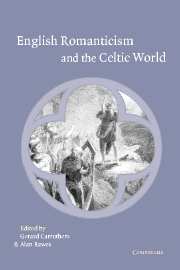Book contents
- Frontmatter
- Contents
- List of contributors
- Acknowledgements
- 1 Introduction: romancing the Celt
- 2 Sir William Jones, the Celtic Revival and the Oriental Renaissance
- 3 The critical response to Ossian's Romantic bequest
- 4 Blake and Gwendolen: territory, periphery and the proper name
- 5 The Welsh American dream: Iolo Morganwg, Robert Southey and the Madoc legend
- 6 Wordsworth, North Wales and the Celtic landscape
- 7 The force of ‘Celtic memories’ in Byron's thought
- 8 Shelley, Ireland and Romantic Orientalism
- 9 Byron and the ‘Ariosto of the North’
- 10 Scott and the British tourist
- 11 Felicia Hemans, Byronic cosmopolitanism and the ancient Welsh bards
- 12 Luttrell of Arran and the Romantic invention of Ireland
- 13 Contemporary Northern Irish poets and Romantic poetry
- Notes
- Bibliography
- Index
6 - Wordsworth, North Wales and the Celtic landscape
Published online by Cambridge University Press: 22 September 2009
- Frontmatter
- Contents
- List of contributors
- Acknowledgements
- 1 Introduction: romancing the Celt
- 2 Sir William Jones, the Celtic Revival and the Oriental Renaissance
- 3 The critical response to Ossian's Romantic bequest
- 4 Blake and Gwendolen: territory, periphery and the proper name
- 5 The Welsh American dream: Iolo Morganwg, Robert Southey and the Madoc legend
- 6 Wordsworth, North Wales and the Celtic landscape
- 7 The force of ‘Celtic memories’ in Byron's thought
- 8 Shelley, Ireland and Romantic Orientalism
- 9 Byron and the ‘Ariosto of the North’
- 10 Scott and the British tourist
- 11 Felicia Hemans, Byronic cosmopolitanism and the ancient Welsh bards
- 12 Luttrell of Arran and the Romantic invention of Ireland
- 13 Contemporary Northern Irish poets and Romantic poetry
- Notes
- Bibliography
- Index
Summary
Wordsworth's Descriptive Sketches of 1793 is a record of his tour of the Alps with Robert Jones in 1790. It was preceded by a dedication to Jones in the form of a letter, ending with a polite reference to Jones's own country:
With still greater propriety I might have inscribed to you a description of some of the features of your native mountains, through which we have wandered together, in the same manner, with so much pleasure. But the sea-sunsets, which give such splendour to the vale of Clwyd, Snowdon, the chair of Idris, the quiet village of Bethgelert, Menai and her Druids, the Alpine steeps of the Conway, and the still more interesting windings of the wizard stream of the Dee, remain yet untouched.
Wordsworth went on to say that he was ‘apprehensive that my pencil may never be exercised on these subjects’, although of course it was. As a discrete and significant part of his work, the treatment of North Wales in his work has never received the attention which it deserves: it has been overshadowed by the encounter with Tintern Abbey and the river Wye on the one hand, and the Lake District landscape on the other. And yet North Wales is important in Wordsworth's work, and its cultural significance is part of the complexity of response to the external world which is found in his poetry. He made two visits there, in 1791 and 1793, and a later one in 1824.
- Type
- Chapter
- Information
- English Romanticism and the Celtic World , pp. 85 - 102Publisher: Cambridge University PressPrint publication year: 2003
- 3
- Cited by



